Home and About Us | Research and Study | Seminars for Parliament Members | Study tours to Abroad |
|||
International Conferences | Publications | How to contact Us | How to order Books |
|
1. The Mongolian Development Research Center sent a 6 persons study team to China (Xinjiang) and Kazakhstan between 12-26 September 1998. The delegation visited Urumqi, the capital of Xinjiang Yugur Autonomous region, China for 6 days 13-18 September. They included Mr. Togtokh, Member of Parliament, Dr. Batjargaj, Director, Center for meteorology, Mr. Enebish, Ministry of Nature and Environment, Mr. Nyamtseren, Ministry of Finance, Dr. Batbayar, Academy of Sciences, Mr. Amar, Executive Director, MDRC. The delegation visited Xinjiang Institute of Geography and Ecology, Animal Husbandry Bureau of Xinjiang government, Xinjiang Pedagogical Institute, and had a study trip to Kazakh minority village. Xinjiang Institute of Ecology and Geography, Chinese Academy of Sciences, established in July 1998, was set up on the basis of two former Institutes: Institute of Desert research and Institute of Geography. The Institute has professional staff of 328 persons, 121 of them are professors, 139 of them are engineers. Major fields of research includes (1) protection of oasis ecology and high-efficient sustainable development of oasis agriculture; (2) monitoring of environmental change of desert and improvement of disasters and techniques on desertification reverses; (3) resourse exploitation of arid and semi-arid land and regional sustainable development. According to the interview with Mr. Tuo Man, deputy director, Agricultural Bureau of Xinjiang government, by the end of 1997 about 105 thousand households of cattle breeders were settled down, which comprises 70 percent of all those households engaged in animal husbandry. Those pastoral households can have access to electricity, water, roads and other necessary services. It meant a big change in the lifestyle of nomadic herdsmen in Xinjiang. 2. The 4 member delegation, including Mr. Togtokh, Nyamtseren, Batbayar, Amar, went to Kazakhstan and stayed for one week 18-25 September. The delegation visited the Development Research Institute of Kazakhstan, Institute for Strategic studies, Economic research institute, and Research Center of Ecology. Mr. Joloman Rustem, President of Development Research Institute received the delagation and explained the topical issues of Kazakhstan development. Agriculture, environment protection, mining, foreign direct investment, and tourism development were of the main interest for the delegation. The delegation was told about the environmental problems, including Aral sea disaster. The delegation exchanged views with Kazakh scholars about the Nazarbaev’s, Kazakhstan President, strategic program “Kazalkhstan 2030”. Development Research Institute of Kazakhstan was founded in 1994 as the private research institute. Its main priority area is economic development of Kazakhstan as well as internal politics and external policy of the country. It has about 70 partners including those from Russia, USA, and other Central Asian republics. Main publication is monthly “Sayasat”. Financing mostly comes from contract with domestic and foreign customers. Yearly budget is about 15 mln. tenge. So far institute produced such publications like “The Elite of Kazakhstan”, “Political Encyclopedia of Kazakhstan”, yearbook of “Modern Kazakhstan”. Kazakhstan Institute of Ecology and Sustainable Development is doing research works on sustainable development of ecologo-economic areas of the Republic, natural use and rehabilitation based on National Environmental Strategy. The institute is involved in issues of integrated ecologo-economic development of selected areas, including the models of environmental stabilization in the crisis regions. It has done research on such issues, like Ecologo-economic assessment of ground ecosystems in Tengiz oil fields, Rangeland capacity of the Ryn sands, Ecological limitations of natural use in Atyrau oblast etc. |
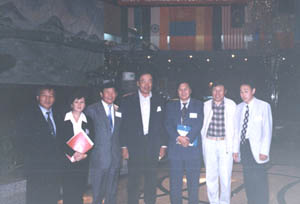 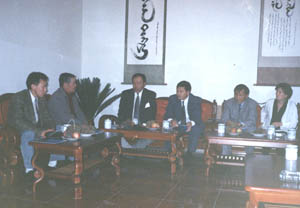 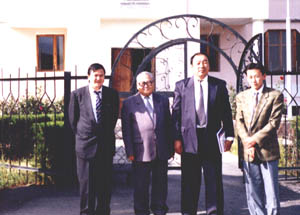 |
|
The MDRC sent 5 member delegation to Turkey on 17-22 October, 1998. The delegation included Mr. J. Boldbaatar, Professor of Mongolian National University, Mr. G. Chuluunbaatar, Director, Institute of Philosophy and Sociology, Mr. S. Lhagva, Expert of National Security Council, G. Nyamdavaa, Rector, Hovdo branch of Mongolian State University, and Ts. Batbayar, MDRC. The delegation stayed 3 days in Istanbul and 4 days in Ankara. 3 day stay in Istanbul mostly included the observation of tourism development in Turkey, including the sightseeing of St. Sophia Museum, Dolmabahche Palace Museum, Galata Tower Museum. Turkey receives every year up to 10 mln. tourists from abroad, revenues from tourism account about 7 - 7.5 bln. USD. The 4 day stay in Ankara included extensive meetings both with government and academic people. The first day (19 Oct.) delegation visited the Constitutional Court of Turkey and met with chairman Ahmet Mehmed. Then we went to National Security Council where we met Gen. Ergin Celasin, Secretary General of that body. In the afternoon, the delegation went to Agricultural Research Center, Ministry of Agriculture and Rural Affairs. Dr. Huseyn Sungur, Deputy General Director told us about the agriculture and animal husbandry in Turkey. Turkey has about 12 mln. cattle and 45 mln. sheeps. The Agricultural Research Center has about 1400 research people working at 55 local research stations. The center runs about 600 projects every year. The delegation paid a visit to Mr. Burhan Kara, Minister without portfolio, and the Chairman of the Turkish-Mongolian intergovernment committee on economics and trade. Mr. Burhan Kara told us about the importance of developing transport links between Turkey and Mongolia including direct flights by MIAT between Ulaanbaatar and Istanbul via Moscow. The second day (20 Oct.) the delegation visited Center for Strategic Research affilated with the Ministry of Foreign Affairs and met its President Amb. Unal Marashli. The Center was established in 1993 and coordinates its research work with Universities, publishes quarterly journal “Perception” , “SAM Reports”. The delegation also visited Turkish Foreign Policy Institute and met its Director Mr. Seify Tashhan. This institute was founded in 1974 is a private cooperation engaged in research, organization for conference and publishing on foreign policy and strategic issues. It is currently affilated to the Turkish Foundation for International Relations and Strategic Studies. It publishes a quarterly journal “Foreign Policy”. In the afternoon, the meeting was held at Tubitak, The scientific and technical research council of Turkey. Its president Dincer Ulku, vice-president Mehmet Cankurtaran told us about the activities of Tubitak. It fulfils two functions, first as the funding agency gives grants to basic science research and applied research. Secondly, it has research panels which investigate submitted proposals. It has a budget of USD 50 mln. The meeting was held in the State Planning Organization, which is one of undersecretariats under Prime Ministry. Mr. Timuchin Sanalan, deputy undersecretary received the delegation and told about the macro economic performance of Turkey in the 1990s. State Planning Organization consists of 6 General Directorates and employs about 700-750 people. Turkey has a liberal trade and economic regime since 1980 and tried to minimize state involvement. Turkey enjoyed 6-7% of average annual growth. The inflation rate has fluctuated during the 1990s but remains high. The unemployment rate is moderate. Many Turks work abroad, which helps to keep unemployment under control: remittances from these workers provide a major source of foreign exchange (about 4 bln. in 1997). |

|
|
1. The Mongolian Development Research Center (MDRC) sent a 5 person high-level delegation to Australia and New Zealand between 20 November and 1 December 1998. The delegation included: (1) Mr. B. Bathishig, Economic adviser to the President of Mongolia (2) Mr. Ochirkhuu, Member of Parliament (3) Dr. Adiyasuren, Adviser to the Minister of Environment and Nature (4) Dr. Namhaijantsan, Director of the Government project on Public Administration restructuring (5) Mr. D. Amar, Executive director, MDRC 2. The delegation first stop was Australia, where they stayed between 20 and 26 November, 1998. On 20 November, Friday, delegation met Mr. Steven Albon, National Policy Manager of Tourism Council of Australia. The Tourism Council which was first founded in 1929 and renamed in 1996, is responsible for developing and promoting Australia’s tourism policies. Council has a membership of 3000 tourist agencies, 30,000 citizens, and a number of airports and hotels. Australia attracts 2.5 million tourists every year and enters into first 25 tourist receiving countries. Delegation learned a lot about tourism promotion policy. The same day, delegation visited Sydney Olympic Coordination Authority and learned on the spot how the Olympic games will promote tourism in Australia. On 21,22 November, Saturday and Sunday, delegation visited Olympic games sites and major tourism centres of Sydney, including Darling Harbour, the Opera House, Sydney Harbour, and Sydney beaches. On Sunday, they moved from Sydney to Canberra. On 23 November, Monday, delegation met Ms. Rhonda Treadwell, Australian Bureau of Agricultural Research and Economics (ABARE). ABARE is Australia’s largest applied economic research agency specializing in agricultural and other natural resource-based commodities. ABARE’s financing comes from government (60%) and from other sources (40%). Afternoon, they visited Murray Darling Basin Commission. That Commision provides a strategic focus for planning and management for the sustainable use of the Basin’s natural resources and has put into place a wide range of initiatives including a broad-based natural resource management strategy including support for community-based works and measures, cooperative education and information programs. On 24 November, Tuesday, the delegation visited nearby superfine sheep farm. The Canberra region is one of the leading centres for superfine wool in Australia. The farm employs 5 person but owns 30,000 heads of sheep. The farm has engaged in other business in order to protect itself from economic crisis. On 25 November, Wednesday, delegation met Mr. John Courtney, Government Department of Foreign Affairs and Trade. Two sides introduced each other respective basic policies in the sphere of foreign trade and foreign investment. On 26 November, Thursday the delegation traveled from Canberra to Sydney for transfer to New Zealand. Second stop for the Mongolian delegation was New Zealand, where they stayed between 27 November and 2 December, 1998. New Zealand program was arranged by Prof. Arthur Grimes, Director of Institute for Policy Studies, Wellington University.The program was focused on Public sector management reform of New Zealand, which included overview of the policy, monetary policy, science system, public sector reform, parliamentary reform, agriculture etc. On 27 November, Friday, delegation was lectured by Prof. Grimes about overview of the New Zealand situation, and by Prof. Viv Hall about New Zealand monetary policy. The delegation learned a lot about New Zealand reform in various spheres, including public and private sector, unemployment, monetary policy. On 28-29, November, Saturday-Sunday, delegation visited countryside area named Marlborough Sounds, which included observation of ostrich farm, and winery. Next day, they went to Featherston, where there is a sheep farm, deer and cattle farm. On 30 November, Monday, delegation was lectured by Ms. Irene Taylor Lake on Public Sector reform, and by Dr. Paul Harris on Parliamentary reform. New Zealand public sector reform deserves special attention for its consistent nature and the delegation exchanged opinions on that matter. On 31 November, Tuesday, the delegation was lectured by Prof. Lew Evans on Light Handed Regulation of Electricity and other Utilities, and by Mr. Neil Fraser on New Zealand agriculture. Then, summary discussion was held at the Institute for Policy studies with Prof. Arthur Grimes. The delegation told him what they learned during their stay in New Zealand and what they think are relevant from New Zealand experience for Mongolia. |
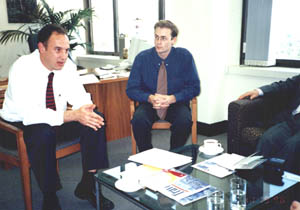 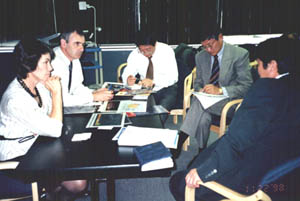  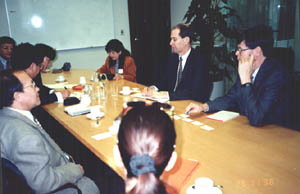 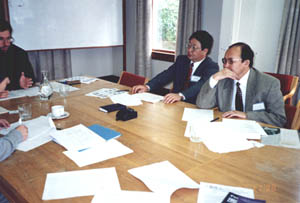 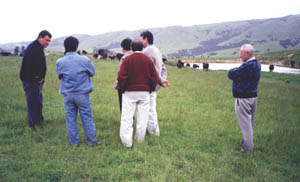 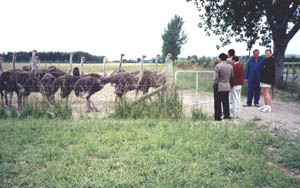 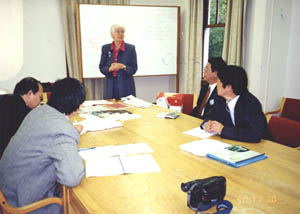 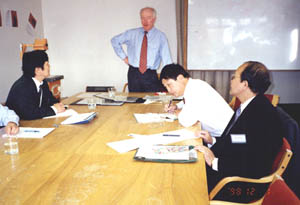 
|
|
The MDRC delegation consisting of 6 persons: 1. Dr. Ts. Batbayar, Chairman of Board, MRDC 2. Dr. S. Lhagva, Member of Board, MDRC 3. Mr. D. Amar, Executive Director, MDRC 4. Prof. Sumio Kuribayashi, Tokyo International University 5. Prof. Tan Hashida, Tokyo International University 6. Mr. Shinichi Kubota, Sasakawa Peace Foundation visited Republic of Buryatia (The Russian Federation) and city of Irkutsk during 26 August and 1 September 1999. The delegation first visited railway border town Naushki on Russian side, the border check point Kyahta in 36 km from Naushki. Kyahta is in opposite side to Mongolian border point named Altanbulak. The visit to Kyahta was interesting because Russo-Mongolian trade exchange and people’s exchange is mostly carried out through this transit corridor Kyahta-Altanbulak. Now extension of new check point is under construction. Last year, the Russian Federation invested US$ 1.168 into the new construction. It will occupy 16 hectares of land. After the extension it can handle 200 cars per day instead of 50 cars today. The delegation met Mr. V.M. Struchkov, head of Kyahta administration and Mr. D.U. Munkuev, deputy head of the administration. They told us about the Kyahta industry which is in a very bad shape and told about the perspectives of Kyahta as free custom zone in near future. During the visit to Ulan-Ude, capital of the Republic of Buryatia, the delegation met Mr. Atanov N.I., Minister of Economy and External Relations, Republic of Buryatia. Mr. Atanov told us about the economic situation of the Republic, and about economic relations between Moscow as center and Buryatia as perifery. Buryat Republic is rich in mineral resources like gold etc.( 9 tonnes were produced per last year). The lake of Baikal, situated in the Republic of Butyatia makes it attractive for foreign tourists. The delegation also met Mr. Leonid V. Potapov, President of the Republic of Buryatia. President told to the delegation about the economic perspectives of the Buryatia and about the people. In Irkutsk, the delegation met Mr. Vasilii P. Sherbak, Deputy chairman of Science Committee, Irkutsk oblast. Irkutsk is planning to host Baikal Economic Forum in autumn 2000. There are some prospects about the realization of Land Bridge project by revitalizing Trans Siberian Railway. |
 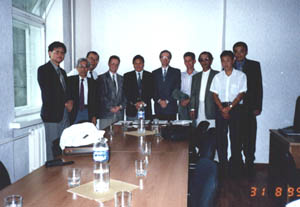 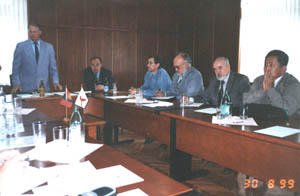 
|
|
The MDRC has organized a study tour to Inner Mongolian Autonomous Region of China for 2 weeks between 21 June and 3 July 1999. The purpose was to study economic reform in rural areas of Inner Mongolia with the focus on land reform, livestock breeding, environment protection and development of small and medium enterprises. The team included: 1. Mr. L. Nyamtseren, officer, Ministry of Infrastructure development 2. Mr. Kh. Dashdondov, Professor, Agricultural University, 3. Mr. T. Chimid, Adviser to MDRC 4. Mr. D. Baatarkhuyag, Vice-Governor, Dornod province 5. Mr. G. Adiya, Vice-Governor, Sukhebaatar province |
|
29 October. Arrival to Beijing by CA 902. The delegation includes 6 persons: 1. Mr. B. Batkhishig, Economic Adviser to The President of Mongolia 2. Dr. Ts. Batbayar, Chairman of Board, MDRC 3. Mr. D. Amar, Executive Director, MDRC 4. Mr. Ch. Nyamdorj, Member of Parliament 5. Mr. Ya. Erkhembayar, Member of Parliament 6. Mr. Ts. Bayarskaihan, Member of Parliament 30 October. Arrival to Goteborg by LH. The delegation arrived to Goteborg via Frankfurt. During almost 7 hour long waiting at Frankfurt airport the delegation had a dinner which. At 23.25 the delegation arrived to Goteborg, where Mrs. Anita Gerdne has met us and took to the Robinson hotel near the center of the city. 31 October. Sunday Because of 6 hour difference the delegation slept until 12.00 and at 14.00 Mrs. Gerdne picked us up and took to her cafe called Cappuchino. The delegation had a lunch there with Mr. Erdenechuluun who is staying at Upsalla. In the evening, we had a dinner at the house of Mrs. Gerdne. Her husband North Gerdne has worked in oil business and now retired 5 years ago. 1 November. Monday At 10.00 we went to University hospital to meet Prof. Peter Horal and had talked to him about health care system in Sweden. Mr. Horal told us that Sweden has a free medical service for all Swedens because everybody pays so-called welfare tax to local and as well as central government. A person coming to a doctor pays just SEK 100 as an entry fee then everything is free of charge. Local government pays for everything. But they are planning to separate services and make them private. Doctors are low paid and they started to move to another countries, like Norway, where they can earn much more. Swedish model of welfare is not working perfectly. At 14.00 we went to Goteborg University to meet Prof. Arne Bigsten who is development economist at School of Economics and Commercial Law. He told us that Swedish economy is a mixed economy, on one hand, it collects high taxes and redistributes for all equally, on other hand, 95 percent of industry is private. Production is private, however, government intervention is still strong. During 1991-92 big speculation boom, so-called bubble, brought a crisis to Swedish economy. One bank was rescued by the government. Sweden went through liberalization of financial market. If in the 1970s Swedish per capita GDP was 3d in the world, now it is 17th in the world. Public debt is about 85% of the GDP. Every year it spends 2% of its GDP to pay off public debt. Sweden should make public debt ratio lower as 60% in order to meet EU criteria. Unemployment is 6% now lower than in early 1990s. Government owns telecommunicastation, hospitals, schools, defence industry. Sweden is highly dependent on foreign trade, it must export much in order sirvive. Less than 1% of the population is employed in agriculture, it produces 2-3% of the GDP. Sweden can join EMU in 2002. 2 November. Tuesday We visited Kanog farm “Partille” located out side Goteborg. The farm is property of the municipality, it is rented by 5 persons. Main characteristics of the farm: -Cultivated area 85 hectares, 1/3 barley, 1/3 oats, 1/3 grassland -Pasture ground 60 ha, 54 cows, 60 heifers, 45 bulls -Farm shop, where they sell mostly horse fodder for local county horse owners One cow gives 11000 ton of milk dayly, they sell to milk factory. Farm has also 4500 hens, and collects 4000 eggs per day. Total income of farm is about 3 mln SEK yearly, and they pay 200,000 SEK to the municipality for rent. 3 November. Wednesday We came to Oslo by SAS which flew only 50 min. from Goteborg. From Airport we came to hotel Norrana where we will stay 3 nights. Mongolian consul Mr. Erik Walstrom came to meet us at 12.00 and took us to his office of the law firm Haavind&Haga. We had an orientation seminar for Norway visit. Mr. Kenneth Pilscog, China Travel Ltd., came to talk to us about the tourism development in Mongolia. This firm sends about 200 Norvegians to Mongolia yearly mostly those who ride Trans Siberian railway. Mr. Walstrom told us some basic things about Norway. Norwegians are sensitive about Sweden which can be explained by history. For more than 400 years, it was ruled first by Danes and then by Swedes. It only gained its independence in 1905 and has spent much of the century forging a national identity. More recently, Norway has become prosperous due to North Sea oil. Its economy is still growing steadily – it is expected to increase by 1 percent this year and 3 percent next year, helped by the doubling of oil price since January. The government is next year expected to add another NKr 71.8 bn to its petroleum fund, the financial safety net for when oil runs out, taking the total nearly NKr 300 bn. Unlike Sweden, Norway has a weak industrial base outside the oil, shipping and fishing industries. There is some state ownership in three large industries: oil, banking and telecoms. The oil industry is dominated by Statoil, which is fully state owned, and Norsk Hydro. In the financial sector, the state also owns a majority of Den norske Bank, the biggest Norwegian bank, as well as its stake in Christiania. Telenor and Telia are 100 percent state owned. But the state remains anxious about the future of the economy once North Sea oil proceeds start to diminish .(it is sufficient for another 25-30 years) 4 November. Thursday At 11.00. we went to Norwegian parliament, Storting, to meet Mrs. Rigmor Kofoed-Larsen, who visited Mongolia this summer as a member of Norwegian parliament delegation. After their return she informed Minister of Foreign Affairs on the visit to Mongolia. They are interested in social sector development in Mongolia, and in developing tourism in Mongolia for Scandinavian tourists. Norway spends about 10 bn NKr (US$ 1.4 bn) per year as development assistance, which is managed by NORAD. However, the development aid is focused on certain countries, like Mosambique, Tanzania, Zambia. Mongolia is not included into this list. At present, some Norwegian NGOs engaged in a few projects in Mongolia, focused on education, street children etc. Afternoon, we visited Norsk Investorforum, where we met Mr. Erik S. Reinert, expert on development economics. He is a critical of IMF or Washington consensus that all economic activities alike. Instead, he argues that like players in different divisions of soccer, countries have industries with different skills. Therefore, he established a small group of economists and political scientists from US, Korea and will hold a conference in August 2000 to reach Oslo consensus. He wrote an paper on”The Role of the State in Economic Growth” in which he argues that narrowly focused and simplistic economic models from the early 1990s, virtually void of any considerations of economic institutions, need profound modifications. 5 November. Friday At 10.00 we went to Royal Ministry of Foreign Affairs to meet Mr. Per Stavnum, Regional adviser for Asia/ Oceania. He told us about bilateral relations. Two countries exchanged visits by Speakers of the Parliament. Min. Tuya’s visit was postponed and expressed hope that it will take place at convenient time in near future. One UNDP project on energy efficiency was funded by Norway. 2 Norwegian NGOs are active in Mongolia. Development cooperation is concentrated on a few countries in Asia, for example, on Sri Lanka, Nepal, Bangladesh and other South Asian countries. Whether Mongolia can be included or not, much will depend on Parliament decision. At 12.00 the delegation came to Agricultural University of Norway, located outside Oslo in 40 min drive. Mr. Svein Skoien told us about agriculture in Norway. Although agriculture, forestry, fishing contributes only 2 percent of the GDP, it is very important in terms of employment and protected by the Government. The Government subsidies the farmers by various measures which amount to 12-13 bn NKr. Family farm size is very small not exceeding 13 cows and obliged to sell the qouta of milk. Norway has 350,000 cows, 91,800 pigs, 1 mln sheeps and 55,700 goats. They slaughter half year old lambs and keep only lambs. In Mongolia about 10 Norwegian agricultural specialists work on vegetable growing (5 somons and 200 families), wool center, cow cross breeding. 80 percent of funding comes from NORAD and the rest from NGOs. 6, 7 November. Saturday, Sunday The delegation comes to Copenhagen by SAS flight at noon on Saturday. Because everything is closed in Denmark in week-ends, we do some sightseeing and shopping. 8 November. Monday In the morning we went to visit a farm nearby Copenhagen. Mr. Mads Midtiby, the owner of the farm, has 125 ha land and 100 cows. He gets 2.5 ton milk per day, 900 ton per year. His income 1995 70,000 DKr 1996 73,000DK 1997 275,000 DK 1998 504,000 1999 350,000 From milk he gets DK 2,194,226 and from meat 229,284. He has two employees, and pays DK 24,000 and 16,000 respectively. At noon, we went to the Danish Agricultural Council, the federation of all kinds of associations, to meet Mr. Jens D. Vesterlund, Head of Department, The Danish Institute of Agricultural Information and Education. He told us basic things about Danish agriculture. Although 3-4 percent of population is employed in agriculture, it generates 7-8 bn US$ exports out of total 70 bn exports. 2/3 of all agricultural products are exported abroad. Number of farmers is decreasing. If 200,000 farmers with an average 16 ha land were in 1960, 60,000 farmers with an average 45 ha registered in 1990. At 14.00 we went to the Ministry of Food, Agriculture and Fisheries to meet Mr. Pederson, Director, International Affairs. He told us about Common agricultural policy within EU. 9 November. Tuesday The delegation went to Danish Institute of Agricultural and Fisheries Economics to meet Mr. Aage Walter-Jorgensen, Senior Economic Adviser. He told us on three subjects: Facts about Danish agriculture, Organization of Agricultural and Fisheries Research in Denmark, and Agricultural policy in the EU. |
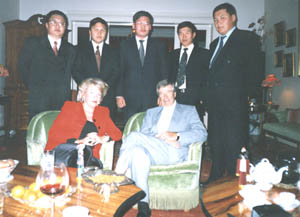 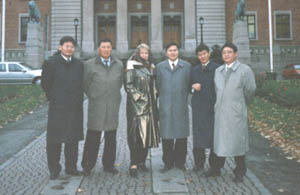 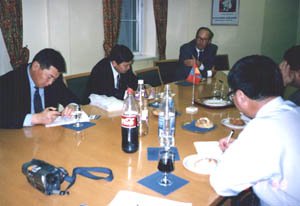     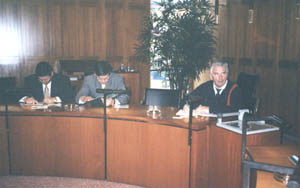  
|
